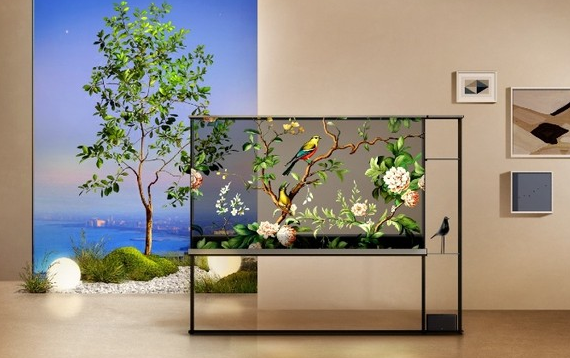LG recently introduced a groundbreaking innovation in home entertainment: transparent OLED TVs. These advanced screens combine high-definition visuals with a unique, transparent display, allowing them to seamlessly blend into any room when not in use. By offering a screen that is both visually stunning and subtly integrated into its surroundings, LG has created a futuristic TV that transforms the viewing experience while enhancing home aesthetics.
The concept of transparent screens is quickly gaining popularity, especially for those who value modern, minimalistic interior design. Unlike traditional TVs that dominate wall space, transparent OLED TVs appear almost invisible when inactive, adding sophistication without taking away from a room’s decor. This makes them ideal for integrating with various home elements like glass walls or furniture, providing functionality without sacrificing style.
This article explores LG’s transparent OLED TV technology, from its key features and unique benefits to its potential applications in both home and commercial spaces. We’ll look into how the technology works, the advantages it brings to home environments, and the considerations for those interested in adopting this new innovation. By the end, readers will have a clear understanding of how LG’s transparent OLED TVs are setting a new standard for the future of home entertainment.

What Are Transparent OLED TVs?
Transparent OLED TVs are a new type of display technology that allows the screen to be both high-definition and partially transparent. OLED, or “organic light-emitting diode,” technology works by using organic compounds that emit light when an electric current is passed through them, allowing for vibrant, high-contrast visuals without the need for a backlight. In transparent OLED screens, these compounds are arranged in a way that allows light to pass through certain areas, creating a screen that appears almost invisible when not actively displaying content.
This technology differs from traditional OLED screens primarily in its transparency. While standard OLED TVs display rich colors and deep blacks on a fully opaque screen, transparent OLED TVs maintain a glass-like quality, allowing viewers to see through the screen when it is not in use. This makes them ideal for situations where aesthetics are a priority, as they blend into the surroundings without obstructing views or taking up wall space. When switched on, transparent OLED screens offer the same vibrant visuals as traditional OLED TVs but with the added benefit of being able to seamlessly disappear when not in use, giving a futuristic touch to any environment.
Key Features of LG’s Transparent OLED TVs
LG’s transparent OLED TVs are a remarkable blend of advanced technology and sophisticated design, making them both functional and visually appealing. By seamlessly integrating high-definition display quality with a transparent, glass-like appearance, these TVs enhance any space with a modern, minimalistic aesthetic. Unlike traditional screens that demand attention, LG’s transparent OLEDs can almost vanish into their surroundings, allowing them to complement rather than dominate a room’s design. This unique blend of technology and style makes them ideal for those looking to add a touch of futuristic elegance to their home or workspace.
The display quality of LG’s transparent OLED TVs is nothing short of impressive, featuring vivid colors, sharp details, and deep contrast, all while offering various transparency modes. When activated, the screen provides the same high-definition visuals expected from OLED technology, but with the additional option to adjust the transparency, allowing users to easily shift between display and “see-through” modes. This makes it possible to use the screen for entertainment, information, or even as an interactive, semi-transparent decor piece, blending smoothly with windows or partitions.
Smart integration and an intuitive user interface are additional highlights of LG’s transparent OLEDs. These TVs support connectivity with other smart home devices, allowing users to control functions through voice commands or a smart hub, integrating with existing home automation systems. They have designed the user interface to be accessible and smooth, ensuring an easy transition between modes and providing quick access to streaming, apps, and device controls. These features make LG’s transparent OLED TVs not only visually stunning but also highly functional, fitting seamlessly into a modern, connected lifestyle.
How Transparent OLED TVs Work
Transparent OLED TVs operate using OLED technology, which stands for “organic light-emitting diode.” Unlike traditional LED screens that rely on backlighting, OLED screens emit light on their own, thanks to organic compounds that light up when an electric current passes through. This allows OLED screens to deliver vibrant colors, deep contrast, and crisp details without needing a backlight, making them thinner and more flexible in design. Transparent OLED TVs, enables the screen to be partially see-through when turned off or in transparency mode.
To achieve transparency, transparent OLED TVs use specialized components that allow light to pass through the display. The organic compounds are arranged in ultra-thin layers and paired with transparent cathodes, which conduct electricity while maintaining the see-through effect. Unlike standard OLED panels, which use reflective or opaque layers, transparent OLEDs use materials that let ambient light pass freely through the screen. This creates a display that appears like a glass sheet when inactive but lights up vividly when in use, showcasing content without obstructing views or occupying significant visual space.
These key components—self-illuminating organic layers and transparent electrodes—enable the transparency function while still delivering high-quality visuals. This technology allows transparent OLED TVs to seamlessly shift between a clear, glass-like mode and a full HD display, making them an innovative solution for integrating digital displays into various environments without compromising aesthetic appeal or functionality.
Benefits of Transparent OLED TVs in Home Environments
Transparent OLED TVs offer a unique advantage in interior design by enhancing the aesthetics of a room without dominating the space. Unlike traditional TVs, which take up visible wall space, transparent OLED screens blend effortlessly into their surroundings. When turned off or in transparency mode, these TVs appear almost invisible, allowing them to complement rather than disrupt the style and ambiance of the room. This makes them a perfect fit for modern, minimalistic interiors where the focus is on clean lines, open space, and seamless integration of technology into the decor.
Another major benefit is their flexibility in placement. Transparent OLED TVs can be mounted on walls, used as freestanding displays, or even installed on windows without obstructing views or blocking natural light. This versatility gives homeowners and interior designers greater freedom to position them in creative ways—whether it’s placing one as a sleek divider in an open-plan space, integrating it within a glass partition, or setting it up in front of a window. With the ability to adapt to various placements, transparent OLED TVs add functionality without the typical restrictions of a standard screen, making them an innovative addition to any modern home.
The Challenges and Considerations
Transparent OLED TVs, while innovative, come with several challenges and considerations that may impact their adoption. The cost is one of the primary barriers. As cutting-edge technology, transparent OLED TVs are considerably more expensive than traditional or even standard OLED TVs, making them less accessible to the average consumer. This high price point is due to the complex manufacturing process and the specialized materials required to create a transparent, high-definition screen. For most households, the investment may feel significant, particularly when other high-quality, affordable options are available.
Another consideration is the durability and visibility of transparent OLED screens. Since these TVs are designed to be both thin and transparent, they may be more susceptible to damage than conventional, thicker displays. Screen durability is an important factor, especially for those with active households or public spaces where the screen might be more exposed. Additionally, because transparent OLED screens are see-through, their display brightness may be lower than traditional OLEDs, which could impact clarity in bright settings.
Lighting conditions can also affect the usability of transparent OLED TVs. In brightly lit rooms or direct sunlight, the see-through effect can make content on the screen harder to view compared to traditional, fully opaque displays. This limitation makes transparent OLEDs best suited for controlled lighting environments where brightness and contrast can be adjusted. While these considerations may impact their practicality in all spaces, understanding these limitations helps consumers make informed decisions about integrating this impressive yet specialized technology into their home.
Conclusion
LG’s transparent OLED TVs represent a remarkable step forward in display technology, offering a unique combination of stunning visuals and seamless integration into modern home environments. These TVs not only deliver high-definition picture quality but also blend effortlessly into their surroundings when not in use, adding sophistication without overwhelming the room’s design. Their flexibility in placement—whether on walls, windows, or as standalone displays—gives users more options for integrating entertainment into their living spaces in a way that feels both functional and stylish.
This technology is redefining the home viewing experience by allowing screens to be less intrusive and more adaptable to interior decor. While there are some considerations, such as cost and lighting conditions, the transparent OLED TV offers a glimpse into a future where displays are not just functional devices but also integral design elements. As this technology evolves, it holds the potential to transform not only how we watch but also how we incorporate digital screens into our everyday spaces, making them a natural and inspiring part of the home.
